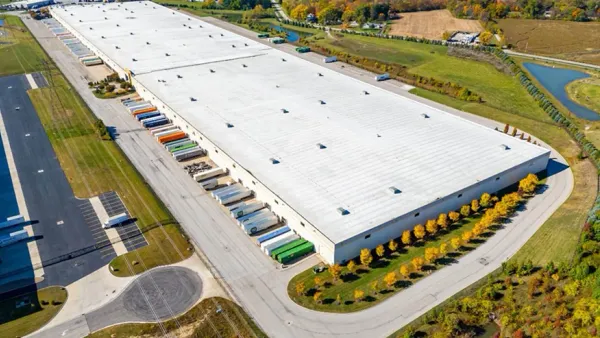Capturing the full environmental, social, and financial benefits of corporate sustainability requires a focus well beyond the four walls of your facilities.
Why? Because manufacturers and supply chain leaders rely on hundreds or thousands of suppliers for:
- Components and materials
- Product packaging
- Maintenance, repair and operations inventory
- Technology solutions
- Transportation and logistics
Unfortunately, it takes only a single supplier’s environmental failure to tarnish your brand. Just as important, suppliers with a focus on sustainability can make themselves more competitive — and improve your bottom line, too.
In fact, a recent CDP study found that 95 percent of organizations report that suppliers demonstrating environmental leadership in sustainable practices are more competitive; only 5 percent say these suppliers are more costly. In addition, 65 percent of CDP members — with a combined procurement spend of $3.6 trillion and more than 7,000 suppliers — report using environmental metrics in their supplier relationship management processes, with another 30 percent planning to do so within two years.1
Advantages/Benefits of Sustainable Supply Chain Management
Sustainability consists of the actions that everyone — individuals, companies, supply chains, countries — can take to avoid depleting natural resources or harming the environment. These include use of renewable resources; purchase of green components and materials to reduce landfill material; reduction of waste via closed-looped production systems; and improving transportation efficiency. These sustainable practices can also boost revenues and profits via improved:
- Customer Retention
- Consumers want to know that companies they do business with share their values, especially around environmental responsibility. For example, manufacturers now apply — and customers now look for — a range of recycling logos on products; these include on-pack recycling labels (OPRLs) that indicate whether the packaging/container is recyclable to logos identifying the raw materials to be recycled (e.g., resins, glass, wood). Missing logos can translate to lost sales: 76 percent of consumers in the United States, UK, Germany, Australia, China, and Brazil want to recycle more, and say that recyclability is the most important sustainability attribute for packaging.2
- Businesses pursuing their own sustainability and environmental impact goals often have supplier criteria requiring sustainable supply chains and/or socially responsible practices. To minimize risks, many companies ask new and existing suppliers to agree to sustainability audits.
- Employee Morale and Retention
- A study of UK employees found that 53 percent say that sustainability is an important factor in choosing an employer. Percentages are even higher among younger workers — 64 percent of 25-34-year-old workers and 67 percent of 16-24-year-old workers.3
- Partnerships
- A well-executed and publicized supply chain sustainability strategy attracts business partners with similar beliefs and objectives — organically helping to build a more sustainable supply chain.
- Corporate Image and Value
- Investments in ESG (environmental, social, and governance) funds doubled from 2020 to 2021, reaching approximately $120 billion.4 In 2021, the EU passed a Corporate Sustainability Reporting Directive that requires stricter sustainability reporting, which could result in some 49,000 European companies disclosing sustainability/environmental impact information by 2023.5
- Corporate Performance
- Manufacturers are leveraging supply chain sustainability efforts to drive more dollars to their bottom lines by what they do and what they don’t do:
- Energy cost savings increase in a sustainable supply chain by using renewable sources (solar, wind); energy capture and reuse technologies; improved maintenance of machines to minimize energy draw; installation of energy-efficient equipment and lighting; improved production scheduling; and logistics strategies to reduce transport distances.
- Production wastes are eliminated by using lean manufacturing and lean supply chain management techniques; substituting recyclable or reusable materials for paper and plastic; minimizing use of chemicals and solvents; and conserving water.
Bringing the Vision for Supply Chain Sustainability to Life
At Performance Solutions by Milliken, we help companies develop and achieve a vision for supply chain sustainability performance, pioneered by our parent Milliken & Co., based on three core components:
- People:
- Sustainable practices always put people first. A vision for a sustainable supply chain focuses on ensuring safe, reliable jobs that support families and communities. This includes measures to track people-centric progress, including zero lost-time safety incidents, workforce inclusivity, data privacy, and level of volunteerism.
- Product
- Goods produced by a sustainable supply chain should support a circular economy, in which products are used, reused, resold, and recycled for as long as possible. This requires a systems approach to change the way companies conceive of design, waste, and raw materials. It also includes analysis of product sustainability and collaboration in supply chain management.
- Planet
- The goal is to continuously reduce a company’s environmental footprint. This requires the application of measures that spotlight a commitment to responsible operations, including measures of greenhouse gas emissions, solid wastes, waste to landfills, water usage, and renewable energy usage.
Policy and Actions for a Sustainable Supply Chain
At Performance Solutions by Milliken, we’ve found that there are four keys to implementing successful sustainability initiatives:
- First, everyone in the company must understand what it means to be sustainable and what makes supply chain sustainability important. This starts with a sustainability policy that clearly articulates a sustainability vision and corresponding goals, along with specific tactics, timelines, and targets.
- Second, everyone in the company must be supported in their pursuit of supply chain sustainability. This includes training and certification programs to deliver technical knowledge, with curricula tailored to each employee’s role, responsibilities, and geographic location. Education also should include cultural components necessary for sustainability to flourish, including a code of conduct that supports individuals’ actions — e.g., the responsibility to communicate concerns and near-misses; to speak up about non-inclusive behaviors; to seek help when needed; and to collaborate in efforts to investigate and resolve problems.
- Third, efforts must be made to educate suppliers about the sustainability vision and goals. Effective communication ensures that suppliers understand their roles in the process, what is expected of them, and how they’ll be held accountable (e.g., supplier audits). Start with the company’s primary suppliers, as well as those with solid track records of sustainability (which can help your company improve its own sustainability practices). If some suppliers balk, begin the process of identifying replacements.
- Finally, report (at least annually) the company’s progress toward sustainability goals, then request feedback from employees, customers, suppliers, and stakeholders — i.e., are the vision and goals helping the company and its supply chain to achieve sustainability or do the vision and goals require revision?
Reach Supply Chain Sustainability with Performance Solutions
Join forces with Performance Solutions by Milliken to develop a sustainable organization and sustainable supply chain practices. Our team of knowledgeable and experienced practitioners develop customized programs to meet a company’s objectives and goals. And with our Supply Chain Excellence methodology, we help our clients extend that effort to business partners, promoting continuous improvement of supply chain sustainability, productivity, and profitability

- CDP Supply Chain: Changing the Chain, CDP Supply Chain Report 2019/2020.
- “Amcor Research Shows Customers Worldwide Want to Recycle More,” Yahoo, Nov. 18, 2021.
- Anthesis, April 16, 2021.
- Tim Quinson, “The ESG Market Is Controlled by a Few Big Investors,” Bloomberg, Dec. 1, 2021.
- Talib Visram, “ESG investing continued to soar in 2021,” Fast Company, Dec. 28, 2021.










